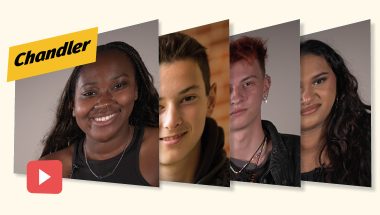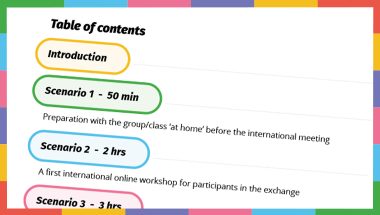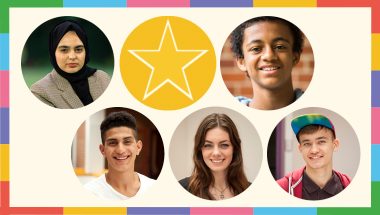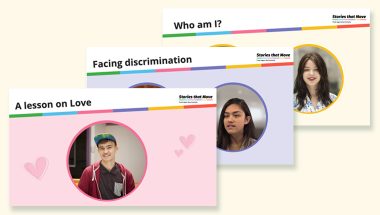Worksheets
We have developed several types of worksheets that you can download from this page. Videos with personal stories of young people from all over Europe are at the core of these lessons.
Below you will find:
- Five worksheets for ELT, CEFR level B2
- International Youth Exchange guidelines
- Four worksheets with digital answer fields using the methods of the online tool
- The digital lessons on our Lesson Up channel (free access)
English Language Teaching worksheets, CEFR level B2 with teachers’ guides

- Chandler, Acting against stereotypes, 30 minutes. Download Chandler Teachers’ guide here.
- Jac & Elias, Showing your Jewish identity, 40 minutes. Download Jac & Elias Teachers’ guide here.
- Kenan, Don’t be a bystander, 30 minutes. Download Kenan Teachers’ guide here.
- Maryam, Migrants as scapegoats, 40 minutes. Download Maryam Teachers’ guide here.
- Rocío, A victim of bullying, 30 minutes. Download Rocío Teachers’ guide here.
International Youth exchanges

- To support educators involved in international youth exchanges, we have developed this guideline featuring four ready-to-use scenarios using elements from Stories that Move.
- Teachers have shared with us the positive responses from their students when they realise that issues that they face, such as inequality and discrimination, are not specific to their country. They say students respond positively to the stories of young people from other countries and that acknowledging the European-wide challenge to deal with these issues has led to engaged conversations within youth exchanges.
Worksheets with digital answer fields

- Meet Robin and Wael: Robin is a Dutch Jew; Wael is a Syrian-Palestinian refugee living in Berlin. Both experience that other people want to hold them accountable for a conflict for which they have no responsibility.
- Who am I? A thought-provoking worksheet about identity and diversity; it invites learners to consider what makes people different. Download educators’ guide for this worksheet here.
- Facing discrimination invites learners to watch two videos and then consider their own reactions.
- Medine’s story takes the first part of the Facing discrimination learning path to help students reflect on their own prejudices, as Medine does.
The digital lessons on our Lesson Up channel (free access)

back to top
 English
EN
English
EN
 EnglishEN
EnglishEN DeutschDE
DeutschDE NederlandsNL
NederlandsNL MagyarHU
MagyarHU PolskiPL
PolskiPL SlovenčinaSK
SlovenčinaSK УкраїнськаUK
УкраїнськаUK EspañolES
EspañolES CatalàCA
CatalàCA

